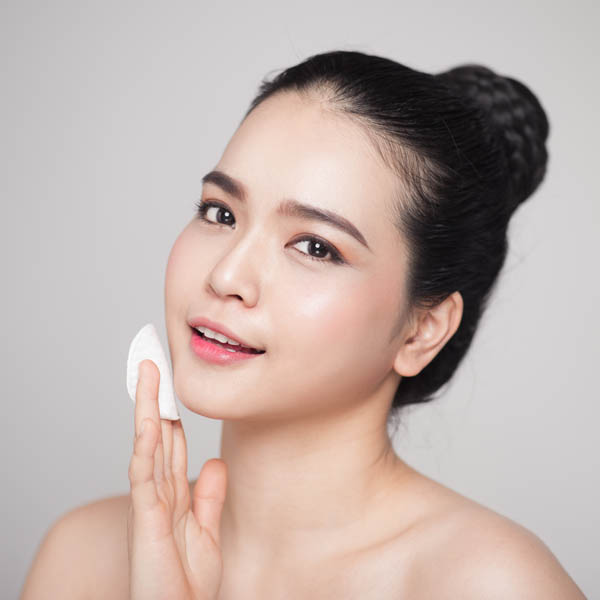Chemical Peel
A chemical peel is a technique used to improve the appearance of the skin on the face, neck, or hands. A chemical solution is applied to the skin that causes it to exfoliate and eventually peel off. The new, regenerated skin is usually smoother and less wrinkled than the old skin. The new skin is also temporarily more sensitive to the sun. There are three basic types of chemical peels:
Superficial or lunchtime peel
Alpha-hydroxy acid or another mild acid is used to penetrate only the outer layer of skin to exfoliate it gently. The treatment is used to improve the appearance of mild skin discoloration and rough skin as well as to refresh the face, neck, chest, or hands.
Medium peel
Glycolic or trichloroacetic acid is applied to penetrate the outer and middle layers of skin to remove damaged skin cells. The treatment is used to improve age spots, fine lines and wrinkles, freckles, and moderate skin discoloration. It also can be used to smooth rough skin and treat some precancerous skin growths, i.e. actinic keratosis.
Deep peel
Trichloroacetic acid, or phenol, is applied to deeply penetrate the middle layer of skin to remove damaged skin cells. The treatment removes moderate lines, age spots, freckles, and shallow scars. Patients will see a dramatic improvement in skin appearance following a deep peel. The procedure is used on the face and only can be performed once.
FAQ’s
What should I do before Chemical Peel?
- Before the procedure, we will clean your face and might cover your eyes with ointment, gauze, tape or goggles. He or she might also protect your hair.
- Pain relief isn’t typically needed for a light chemical peel. If you’re having a medium chemical peel, you might have the option of taking a sedative and a painkiller.
- If you’re having a deep chemical peel, we will likely numb your skin with a local anesthetic and give you a sedative or use regional anesthesia — which numbs a certain part of your body.
What should I do after Chemical Peel?
The short answer is, after treatment, you’ll have glowing, plump, even skin, which feels unusually and satisfyingly clean. Optimal results will be seen a few days later. But as with any facial treatment, the best results will occur from going on a regular basis, typically once a month.
After a chemical peel of any depth, follow your doctor’s directions for cleansing, moisturizing, and applying protective ointments to your skin.
After a light chemical peel, treated skin will be red, dry, and mildly irritated -although these effects might be less noticeable with each repeat treatment. Your doctor might apply a protective ointment, such as petroleum jelly, to soothe the area.
Treated areas take about one to seven days to heal after a light chemical peel. New skin might temporarily be lighter or darker than normal.
After a medium chemical peel, treated skin will be red, tight, and swollen. You’ll feel stinging. Your doctor might apply a protective ointment, such as petroleum jelly, to soothe the area.
Use ice packs or the breeze from a fan for comfort. Over-the-counter pain-relieving medication, such as ibuprofen (Advil, Motrin IB, others) and naproxen sodium (Aleve, others), may help reduce any discomfort. You’ll likely schedule a checkup soon after your treatment so that your doctor can monitor your healing. As swelling decreases, treated skin will begin to form a crust and might darken or develop brown blotches. Treated areas take about seven to 14 days to heal after a medium chemical peel, but redness might last for months.
After a deep chemical peel, you’ll experience severe redness and swelling. You’ll also feel burning and throbbing, and your eyelids might swell shut.
Your doctor will apply a watertight dressing to treated skin. He or she might also prescribe painkillers. Sleeping in a semi-reclined position may help reduce swelling.
Treated areas will develop new skin within about two weeks after a deep chemical peel, although cysts or white spots might appear for several weeks, and redness might last for months. Treated skin might become darker or lighter than normal or lose the ability to tan.
You might prefer to remain at home while you’re healing from a chemical peel. Once new skin completely covers the treated area in about two weeks, you can use cosmetics to conceal any redness.
Client’s Testimonials
A Bit of Our Trusted Reviews
“First time laser treatment here! Great service and knowledgable staff. Highly recommend people who are looking for any beauty service. The front desk is very friendly!”
- Winnie Y., Pasadena, CA
“Went in so I can check out the laser treatments offered. I asked alot of questions and tried to side track the consultation lady but she seemed to know what she was talking about. I ended up going with an acne facial first then I will have laser treatments for my mild acne spots.”
- Mommy S.Azusa, CA
“Went in so I can check out the laser treatments offered. I asked alot of questions and tried to side track the consultation lady but she seemed to know what she was talking about. I ended up going with an acne facial first then I will have laser treatments for my mild acne spots.”
- Mommy S.Azusa, CA
Facials & Skin Care
Cosmetic Procedures – Skin Care – Body Treatments


Facials


Diamond Glow

